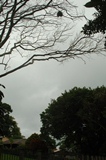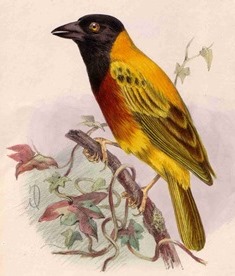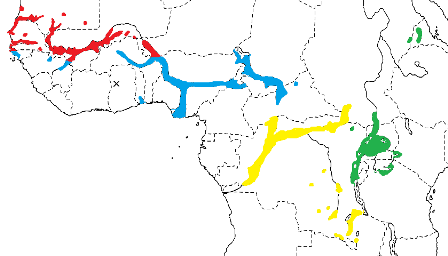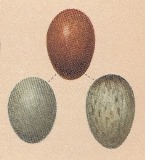Weaver species
Choose different species from drop-down list and press 'Go' button. See Full species list.Yellow-backed Weaver Ploceus melanocephalus
IUCN: Least concern Discovery: 003Categories: wetland, Linnaeus, nectar, pest, palm,
News items about species
Discovery
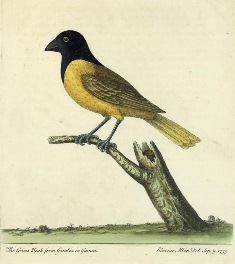
figure from Albin 1738 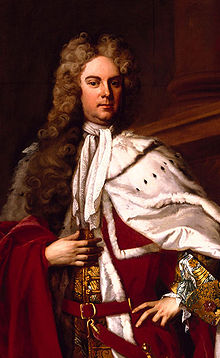
the Yellow-backed Weaver type, figure from wikipedia 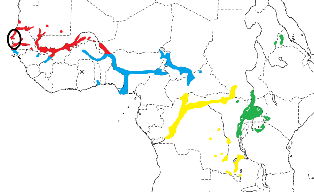
type locality circled IntroductionLinnaeus based this species description on the publication of Eleazar Albin. Albin based his illustration and text of this species on birds in the aviary of Grace the Duke of Chandos, James Brydges.Albin, an English naturalist and water-colour illustrator, included a short text and copper plate engraving illustrations in his book "A natural history of birds", and Vol 3 contained the Yellow-backed Weaver. Albin called the bird Gamboa Groasbeak. Linnaeus listed the type locality as Gvinea, based on Albin's locality of Gamboa on the coast of Guinea. A distinct subspecies of the Yellow-backed Weaver occurs in coastal Guinea, so Albin's locality probably refers to Gambia, as surmised by Brisson 1760. Scientific citationLoxia melanocephala Linnaeus 1758 Syst. Nat., ed. 10, p.175 GuineaMeaning of namesmelanocephala (Greek) Melas, black; -kephalos, headedFirst English nameThe Gamboa Groasbeak (Albin 1738).Alternate namesBlack-headed Weaver, Yellow-collared WeaverCollectorUnknown, sent to the Duke of Chandos in England.Date collectedBefore 1735, when Albin painted the bird (date on painting: 9 Sept 1735).Locality collectedProbably Gambia.Type specimensNo type specimens known to survive, but the painting of Albin serves as a type. |
The above is based on Weaver Wednesday 2, a weekly series about the discovery of each weaver species.
This species text first appeared as
Weaver Wednesday [120] - Discovery [3]: Yellow-backed Weaver on 2014-10-01
1. Basic biology

probably nominate race
Identification The Yellow-backed Weaver Ploceus melanocephalus, sometimes known as the Black-headed Weaver, is found mainly along rivers and wetlands. The breeding male has a black head, and the underparts vary from bright yellow in the west to chestnut with a yellow belly in the east. It differs from the very similar Golden-backed Weaver by having a yellow hind collar that contrasts with a plain green back, slender bill with curved culmen, and a brown (not red) eye. The larger Village Weaver has a yellow back with a black 'V', red eye, and a heavy bill. The female Yellow-backed Weaver is sparrowy - it is much browner than the female Golden-backed Weaver, with no yellow on the underparts except for a little on the throat. In West Africa the female and non-breeding male Yellow-backed Weaver resemble the Vitelline Masked Weaver but have pale (not orange) eyes, and a 2-toned bill (black above, pinkish brown below). Distribution
Four subspecies of the Yellow-backed Weaver are recognised (see map below, based on Birds of Africa). The subspecies differ in the breeding plumage of the male:
Habitat The Yellow-backed Weaver inhabits damp areas with tall grass near rivers or standing water, and is also found in reedbeds and papyrus, but it may forage in tree savanna in drier areas. Food The Yellow-backed Weaver feeds on seeds and insects, while the young are fed mostly with insects. The Yellow-backed Weaver forms flocks in the non-breeding season. Breeding
The Yellow-backed Weaver is polygynous, with two or three females in his territory simultaneously, but is sometimes monogamous. The Yellow-backed Weaver is a solitary nester, or colonial and may nest alongside other weavers. The male displays by fluttering his wings while hanging below the nest entrance. The nest is globular or onion-shaped, and there is no entrance tube. The outer shell of the nest is tightly woven by the male from grass, and a ceiling layer of grass strips is included. The nest is lined by the female with fine grass, and sometimes with some feathers. The nest is slung between vertical stems or supported at one side only in elephant grass, reeds, or papyrus over water, or even in a maize field. Sometimes nests are suspended from twigs in a bush or small tree, usually more than 2 m above the ground. The male repairs damage to nests during construction, but not once a nest is occupied. Leaves are stripped around the nest, making it conspicuous.
The clutch is 2-3 eggs. The eggs vary and may be dull white, blue-green, pinkish-grey or brown, either plain or heavily freckled with olive-brown. Incubation is by the female only, but both sexes feed nestlings. Brood parasitizm by the Diederik Cuckoo Chrysococcyx caprius has been recorded. |
The above is based on Weaver Wednesday, a weekly series about weaver species.
This species text first appeared as
Weaver Wednesday [107]: Yellow-backed Weaver on 2014-07-02
2. Breeding facts
| Pair bond Polygynous, with two or three females in territory simultaneously; sometimes monogamous Breeding season May-Oct in Mauritania, Apr-Nov in Senegal, Jun-Sept in Gambia, Jul-Oct in Mali, Aug-Oct in Bukina Fasso (Jul-Aug at Ouagadougou), Jun-Nov in Niger, Aug in Togo, May and Jul-Oct in Nigeria; in DRCongo, Jun-Aug in NE, Nov-Apr in Kimbombo, Jan-May in Itombwe and E region, Aug-Sept in C regions; Aug-Sept in Sudan and Ethiopia, Mar-May and Aug-Sept in Uganda and Feb-Mar in Zambia Nest site slung between vertical stems (supported at one side only) in elephant grass, reeds or papyrus over water, sometimes suspended from pendulous twigs in bush or small tree, even in maize (Zea mays) field, generally more than 2 m above ground or water level Nest building woven by male, lined by female Colony size No information Clutch size 2-3 eggs Egg colour dull white, blue-green, pinkish-grey or brown, either plain or heavily freckled with olive-brown Egg size average size of ten eggs 18.9 x 13.8 mm (Nigeria) Incubation incubation by female only Chicks and nestling period both sexes feed nestlings and fledglings |
Breeding information based on Handbook of the Birds of the World, Vol. 15.
3. Photos of Weaver Nests
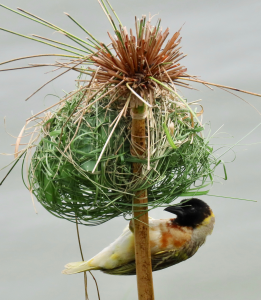 Vm 30392 |  Vm 28588 | 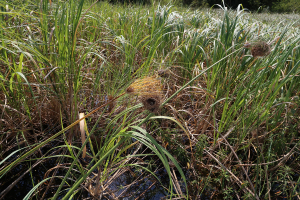 Vm 26336 | 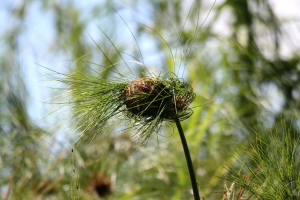 Vm 26183 |  Vm 26182 | 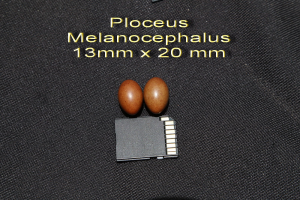 Vm 25068 |
Thumb-nails of most recent PHOWN records - click on one to see its full record
See all PHOWN records for this species here.
PHOWN (Photos of Weaver Nests) provides valuable info on breeding distribution and colony sizes of weavers.
You can contribute by registering and submitting photos at Virtual Museum webpage.
4. Breeding distribution
Google map showing distribution (For species with small ranges you need to zoom in at the correct area to see the range):
yellow blob - range of weaver species; read more about this here.
![]() - PHOWN records with photos
- PHOWN records with photos
![]() - PHOWN records with no photos (Nest Record Cards, other records)
- PHOWN records with no photos (Nest Record Cards, other records)
![]() - Birdpix records
- Birdpix records
![]() - comments on out of range records, or interesting records
- comments on out of range records, or interesting records
![]() - type locality
- type locality
CLICK on the marker on the map to see individual record details.
5. Range changes
Not South African speciesThe above is based on Weaver Wednesday 3, a weekly series about range changes in South African weaver species.
This species text first appeared as
n/a








